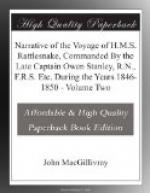During our stay here the ship was daily visited by canoes from Pig Island and its vicinity, also from a village or two on South-east Island, a few miles to the eastward of our anchorage. They usually made their appearance in the morning and remained for an hour or so, bartering coconuts, yams, ornaments and weapons for iron hoop, knives, and axes. After leaving us, those coming from the eastward, as the wind was unfavourable for their return, landed at the mouth of the creek and waited for the floodtide. Our intercourse throughout was peaceful, which was fortunate for both parties, for, if inclined to be hostile, the natives might frequently have attacked our watering-boats while passing up and down the river, impeded occasionally by dead trees and shoals, with a dense forest on each side. Latterly, however, as if suspicious of our intentions or tired of our protracted stay, they fired the grass on the hill at the entrance of the creek, possibly to deter us from entering. Still we thought this might have been done without reference to us, but afterwards two or three men with spears were seen by passing boats skulking along the banks of the river on their way to the rapid, where they again set fire to the grass as if to smoke us out or prevent our return. But the grassy tracts along the tops of the low hills in the vicinity being intersected by lines and patches of brush the fire did not extend far, as had also been the case lower down, so caused us no inconvenience.
Among our numerous visitors we occasionally saw a woman or two, but none were favourable specimens of their kind. Unlike the men, whose only covering was the breech-cloth formerly described, the women wore a short petticoat of grass-like stuff, probably the pandanus leaf divided into fine shreds—worked into a narrow band which ties round the waist. They usually, when alongside the ship, held a small piece of matting over the head with one hand, either to protect them from the sun or partially to secure themselves from observation, as in their manners they were much more reserved than the men.
VARIOUS MODES OF PAINTING.
At Coral Haven we have already seen considerable variety displayed in the various styles of painting the body. Pounded charcoal mixed up with coconut oil, and lime obtained from burnt shells similarly treated, are the pigments made use of. The most common fashion of painting is with a broad streak down the forehead, and a circle round each eye. Occasionally the entire body is blackened, but often the face only—with daubs of paint on the temples, cheek, and round the mouth and one or both eyes, rendering a forbidding countenance inexpressibly hideous in our sight.
NATIVE ORNAMENTS.




